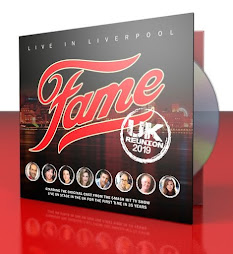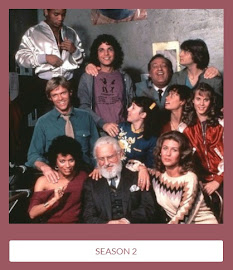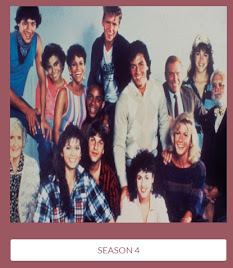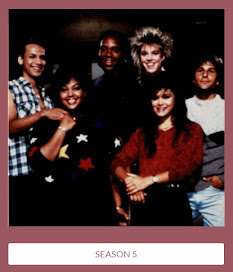
The story behind the cover shoot for Janet Jackson’s Rhythm Nation 1814
Two decades after the singer’s 1989 album catapulted her to stardom, we speak to Guzman, the photography duo behind the iconic cover shot
Text Miss Rosen
Sombre church bells sound as Janet Jackson’s Rhythm Nation 1814 begins. An eerie, unsettled feeling unfolds as Jackson recites the “Pledge” her voice layered to suggest a group who are bound together on this journey as one: "We are a nation with no geographic boundaries, bound together through our beliefs. We are like-minded individuals, sharing a common vision, pushing toward a world rid of colour-lines."
Then she dropped “Rhythm Nation” and the world would never be the same. On her fourth studio album, Jackson transformed from pop star into an icon.
Forever defiant and entirely her own, Jackson refused to give the record label what they wanted, a sequel to Control. But she had bigger things on her mind, and used her art to make a political statement about issues of race, bigotry, gun violence, poverty, drug abuse, illiteracy, and ignorance.
At 23-years-old, Jackson walked the talk. She co-wrote and co-produced every song on the album with Jimmy Jam and Terry Lewis, except the hard rock gem, “Black Cat”, which she penned and Jellybean produced. Rhythm Nation dropped 12 September 1989 and was envisioned as the national anthem of the 90s, thus the “1814”, a reference to the year the “The Star-Spangled Banner” was written.
Rhythm Nation shattered records left and right, becoming the first album to have seven top five hit singles on the Billboard Hot 100, and earning Jackson nine Grammy Award nominations, including the first woman up for Producer of the Year and the only artist in history to receive nominations spanning five genres on a single album.
Now, 30 years after changing the game, Jackson will finally be inducted into the Rock & Roll Hall of Fame, in a star-studded event on March 28, alongside Stevie Nicks, The Cure, Def Leppard, Roxy Music, Radiohead, and the Zombies. The Rock and Roll Hall of Fame will host a Class of 2019 exhibition, featuring iconic items from their careers – including the unforgettable portrait of Jackson taken by Guzman, which appears on the album cover.
Guzman is the husband-and-wife team of Constance Hansen and Russell Peacock, who, below, share memories and never-before-seen images from the iconic shoot.
Then she dropped “Rhythm Nation” and the world would never be the same. On her fourth studio album, Jackson transformed from pop star into an icon.
Forever defiant and entirely her own, Jackson refused to give the record label what they wanted, a sequel to Control. But she had bigger things on her mind, and used her art to make a political statement about issues of race, bigotry, gun violence, poverty, drug abuse, illiteracy, and ignorance.
At 23-years-old, Jackson walked the talk. She co-wrote and co-produced every song on the album with Jimmy Jam and Terry Lewis, except the hard rock gem, “Black Cat”, which she penned and Jellybean produced. Rhythm Nation dropped 12 September 1989 and was envisioned as the national anthem of the 90s, thus the “1814”, a reference to the year the “The Star-Spangled Banner” was written.
“We made small directions but she really didn’t need it. We were just watching her. It was very voyeuristic” – Constance HansenJackson knew what the people wanted, and she delivered. “Miss You Much”, the lead song on the album, was a number one hit – and the second most popular song of 1989. With three more number ones on deck, Jackson was poised to have the bestselling album in the US in 1990 – her legend growing bigger with each and every hit.
Rhythm Nation shattered records left and right, becoming the first album to have seven top five hit singles on the Billboard Hot 100, and earning Jackson nine Grammy Award nominations, including the first woman up for Producer of the Year and the only artist in history to receive nominations spanning five genres on a single album.
Now, 30 years after changing the game, Jackson will finally be inducted into the Rock & Roll Hall of Fame, in a star-studded event on March 28, alongside Stevie Nicks, The Cure, Def Leppard, Roxy Music, Radiohead, and the Zombies. The Rock and Roll Hall of Fame will host a Class of 2019 exhibition, featuring iconic items from their careers – including the unforgettable portrait of Jackson taken by Guzman, which appears on the album cover.
Guzman is the husband-and-wife team of Constance Hansen and Russell Peacock, who, below, share memories and never-before-seen images from the iconic shoot.
Can you take us back to the shoot and describe Janet’s arrival?
Constance Hansen: We started doing 8x10 Polaroids around 1987. We were working with Geoffrey Beene and Barney’s. Janet liked that look.
Russell Peacock: Janet knew exactly what she wanted. This was a big political statement on her part. After hair and makeup, she came in like a soldier.
Constance Hansen: A little girl came in. She was really a little girl, so cute, fresh-faced, no makeup. She was soft, very sweet, and had the tiniest, lovely voice – really delicate. She came with her boyfriend at that time, René Elizondo Jr. They were very cute together. It was a secret.
(Elizondo and Janet were married from 1991 to 2000. He co-wrote 37 of Janet’s songs and directed a few videos.’ Most famously, it was his hands covering Janet's breasts in the photograph that appeared on the cover of the September 1993 issue of Rolling Stone magazine and janet. Album. They kept the marriage a secret until they divorced.)
What stood out to you most about the shoot?
Russell Peacock: The thing I remember most vividly from the shoot happened while we were waiting for Janet to finish her hair and makeup. René invited us into his brand new Range Rover and we listened to ‘Black Cat’ full blast, everything was popping. It was the loudest car stereo I had ever been in and he was really excited.
Constance Hansen: It was a very long hair and makeup session, which is always the case when you are doing something like this. When she came out five hours later, it was the whole military look: the bandolier, the hair, the braiding, the key earring – what she wore in the ‘Rhythm Nation’ video.. That was the look but it was a very simple set. We just had a chair and it was very solemn, very stern. There is no laughing on the set.
I am always looking at what people are doing, how they are feeling. Once we got started it was almost like watching a stage because it was separate. We made small directions but she really didn’t need it. We were just watching her. It was very voyeuristic.

Could you talk about the process for making these photographs?
Russell Peacock: With the 8x10, you can’t look through the camera when you take the picture, so you say, ‘Don’t move,’ put the film in, click it, and hope the person didn’t move too much because it’s a shallow depth of field. It’s an old fashioned way of working. You can’t take a lot of pictures like this. It’s a lot of set up – then you do it and that’s it.
Constance Hansen: We were there a long time but we didn’t have that many images because it’s time-consuming. You are under a dark cloth, looking through the lens. When you are doing that, you are quite still. An exposure could be 15-30 seconds. We were controlling the perspective. You can make people thinner or taller, right in the camera, not in post. There was no post. Everything had to be perfection.
What makes this style of portraiture so revealing?
Constance Hansen: It’s more considered and it’s intimate. You’re really fixated on detail.
Russell Peacock: You get that look like in a daguerreotype, where people look like they are in a trance because they can’t move. You get this surreal feeling. I think during that time, what we liked about it was there was a neo-romanticism to the whole process.
Seeing the outtakes from the shoot, I realised the originals were colour, not black and white!
Russell Peacock: Yes, all the Polaroids were colour.
Constance Hansen: The black and white photographs are Russell in the darkroom and he really is a master. They were manipulated and various things happened. He sometimes solarises them subtly or he tones them with selenium or he bleaches them. Also, you see the numbers ‘1814’, which is on the side – that was added in the darkroom.
Russell Peacock: I made all these different prints for them to choose from but they used a pretty simple straight forward image in the end. After watching the videos, which we didn’t see, I realised what she wanted, whereas at the time, I wasn’t really sure. We didn’t even listen to the music aside from that one track.
Russell Peacock: With the 8x10, you can’t look through the camera when you take the picture, so you say, ‘Don’t move,’ put the film in, click it, and hope the person didn’t move too much because it’s a shallow depth of field. It’s an old fashioned way of working. You can’t take a lot of pictures like this. It’s a lot of set up – then you do it and that’s it.
Constance Hansen: We were there a long time but we didn’t have that many images because it’s time-consuming. You are under a dark cloth, looking through the lens. When you are doing that, you are quite still. An exposure could be 15-30 seconds. We were controlling the perspective. You can make people thinner or taller, right in the camera, not in post. There was no post. Everything had to be perfection.
What makes this style of portraiture so revealing?
Constance Hansen: It’s more considered and it’s intimate. You’re really fixated on detail.
Russell Peacock: You get that look like in a daguerreotype, where people look like they are in a trance because they can’t move. You get this surreal feeling. I think during that time, what we liked about it was there was a neo-romanticism to the whole process.
Seeing the outtakes from the shoot, I realised the originals were colour, not black and white!
Russell Peacock: Yes, all the Polaroids were colour.
Constance Hansen: The black and white photographs are Russell in the darkroom and he really is a master. They were manipulated and various things happened. He sometimes solarises them subtly or he tones them with selenium or he bleaches them. Also, you see the numbers ‘1814’, which is on the side – that was added in the darkroom.
Russell Peacock: I made all these different prints for them to choose from but they used a pretty simple straight forward image in the end. After watching the videos, which we didn’t see, I realised what she wanted, whereas at the time, I wasn’t really sure. We didn’t even listen to the music aside from that one track.

What did you think when you finally heard Rhythm Nation?
Constance Hansen: When I heard the album, it was mind-blowing. It was a big deal. The military look, it was so different. It was a statement by a woman.
Russell Peacock: I don’t think I fully appreciated the message.
Constance Hansen: I think women did though (laughs). Janet knew exactly how she wanted to appear. She had thought about it.
Russell Peacock: I think she was very competitive with Michael. I don’t think it’s a negative thing, I think she wanted to be her own Jackson. Think of how difficult that is to be ‘Michael’s little sister’. That was the point where she really came out on her own and I think that’s what people like about that album: she’s very independent and she is establishing herself as an artist. At the same time, I think it was influenced by Michael.
Constance Hansen: But on a woman, there’s a big difference. There was such strength. I like that she was feisty (laughs). And she looks bigger than life, after knowing that she was this little girl, was fascinating – the transformation.
Russell Peacock: There’s a lot going on in that album, that period of her life, and it shows. I was expecting the kind of previous album, that girl. That’s always the case because artists are always transforming. The need to keep continually reinventing yourself is a challenge but that’s’ what it’s about. In a way, it’s almost like an actor performing a different character.
Constance Hansen: It might not be someone else, it might be themselves amplified.
In celebration of the album’s 30th anniversary, Park MGM hosts Janet Jackson: Metamorphosis, her Las Vegas Residency, opening May 17
Constance Hansen: When I heard the album, it was mind-blowing. It was a big deal. The military look, it was so different. It was a statement by a woman.
Russell Peacock: I don’t think I fully appreciated the message.
Constance Hansen: I think women did though (laughs). Janet knew exactly how she wanted to appear. She had thought about it.
Russell Peacock: I think she was very competitive with Michael. I don’t think it’s a negative thing, I think she wanted to be her own Jackson. Think of how difficult that is to be ‘Michael’s little sister’. That was the point where she really came out on her own and I think that’s what people like about that album: she’s very independent and she is establishing herself as an artist. At the same time, I think it was influenced by Michael.
Constance Hansen: But on a woman, there’s a big difference. There was such strength. I like that she was feisty (laughs). And she looks bigger than life, after knowing that she was this little girl, was fascinating – the transformation.
Russell Peacock: There’s a lot going on in that album, that period of her life, and it shows. I was expecting the kind of previous album, that girl. That’s always the case because artists are always transforming. The need to keep continually reinventing yourself is a challenge but that’s’ what it’s about. In a way, it’s almost like an actor performing a different character.
Constance Hansen: It might not be someone else, it might be themselves amplified.
In celebration of the album’s 30th anniversary, Park MGM hosts Janet Jackson: Metamorphosis, her Las Vegas Residency, opening May 17










































No comments:
Post a Comment